Guitar Chord Chart
Choose a chord
Welcome to the Guitar Tricks Guitar Chords Chart. Here we outline in detail every guitar chord including the basic major chords, minor chords, augmented chords and diminished chords. This chart will show each chord and all possible chord extensions. The perfect tool to help with any online guitar lessons. Every chord is diagramed with proper fingerings and up to 5 voicings/variations for each chord. Click on any chord name to see every possible guitar chord variation from that name. Continue reading below for more details on different chord qualities.
Major Guitar Chords Chart
Major chords are considered ‘happy’ sounding chords and convey positive feelings through music. Major chords are always implied in the notation of music. If there is a single ‘E’ above music notation, that means an ‘E Major’ chord should be played in that spot. All other chord qualities have individual markings. Major chords are the easiest chords to learn and are quintessential for anyone taking guitar lessons. Knowing these will allow you to be able to play hundreds of songs. Check out the guitar diagrams below to learn all major chords playable on the guitar.
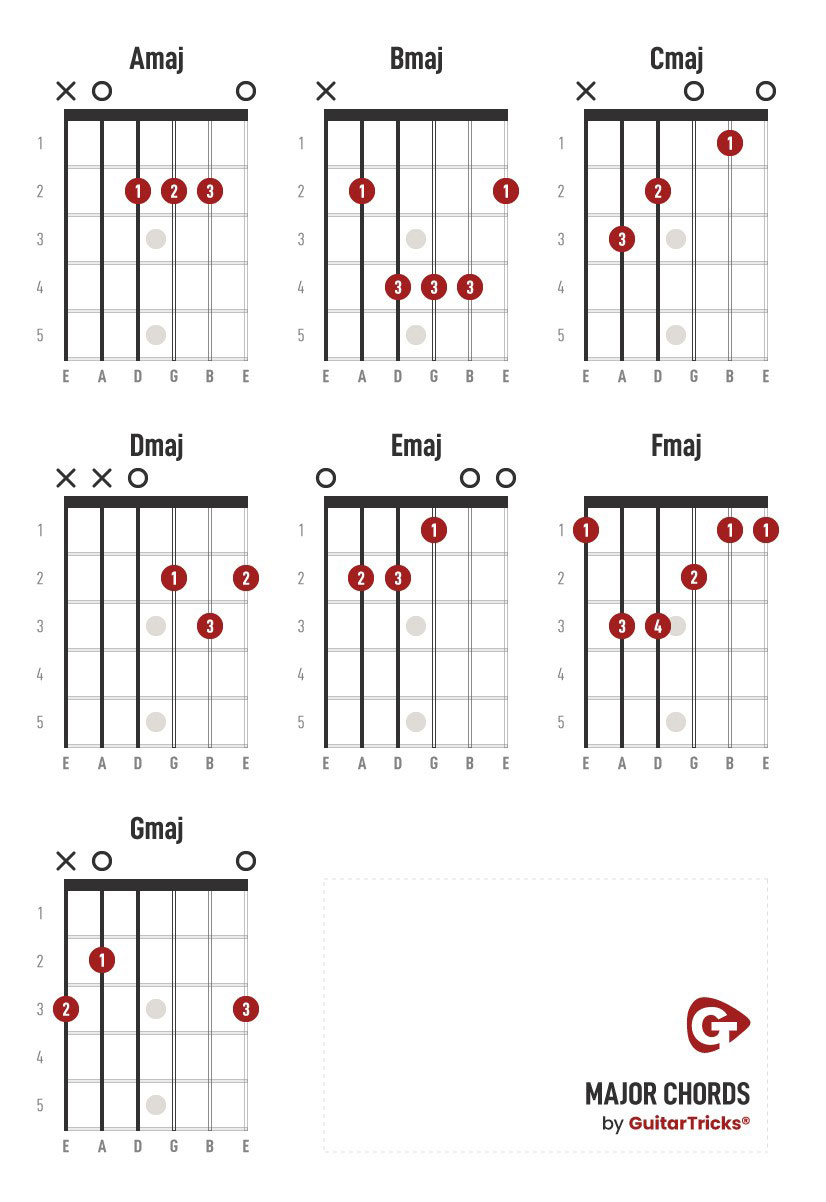
Learn some simple songs right away with our list of 10 Famous Songs with Three Chords Or Less.
Minor Guitar Chords Chart
Minor chords are the counterpart to major chords and convey ‘sad’ emotions through music. Learning minor chords is the next step to mastering the guitar since they are the ‘other half’ for knowing tons of easy guitar songs. They are represented with an ‘m’ or ‘min’ after the chord name – ex. Am or Amin. Minor chords tend to sound ‘sad’ because of the lowering of the ‘third’ note in the related scale by one half-step. Below are the fingerings for open minor chords.

Dominant 7th Guitar Chords Chart
Learn more about 7th chords on our blog here.
These chords get their name from the seventh scale degree within the structure of the chord either as a major 7, dominant 7, or the less-used diminished 7. Major 7th chords sound ‘jazzy’ and have a smooth and pleasant sound to them. They are a great substitution to the block major chord fingering. Dominant 7th chords are featured a lot in rock n roll and blues music. Diminished 7th chords are a bit more advanced and typically only occur in classical and jazz music. Here is a diagram of the most common 7th chords; the dominant 7th.
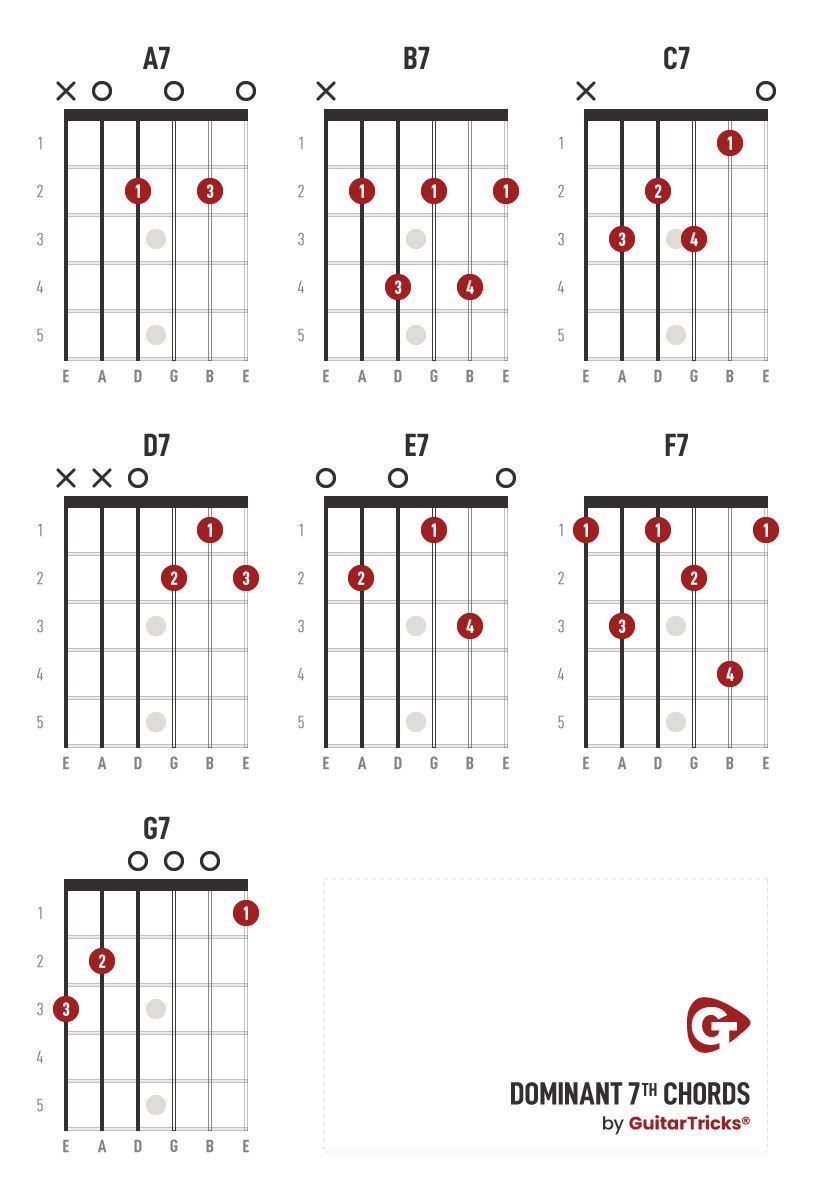
Minor 7th Guitar Chords Chart
Minor 7th chords are minor chords with dominant 7th extensions (attached to the chord) typically marked as ‘m7.’ These chords are ‘moody’ and lend to mellow sounds in music. Below are the diagrams for the basic minor 7th chords.
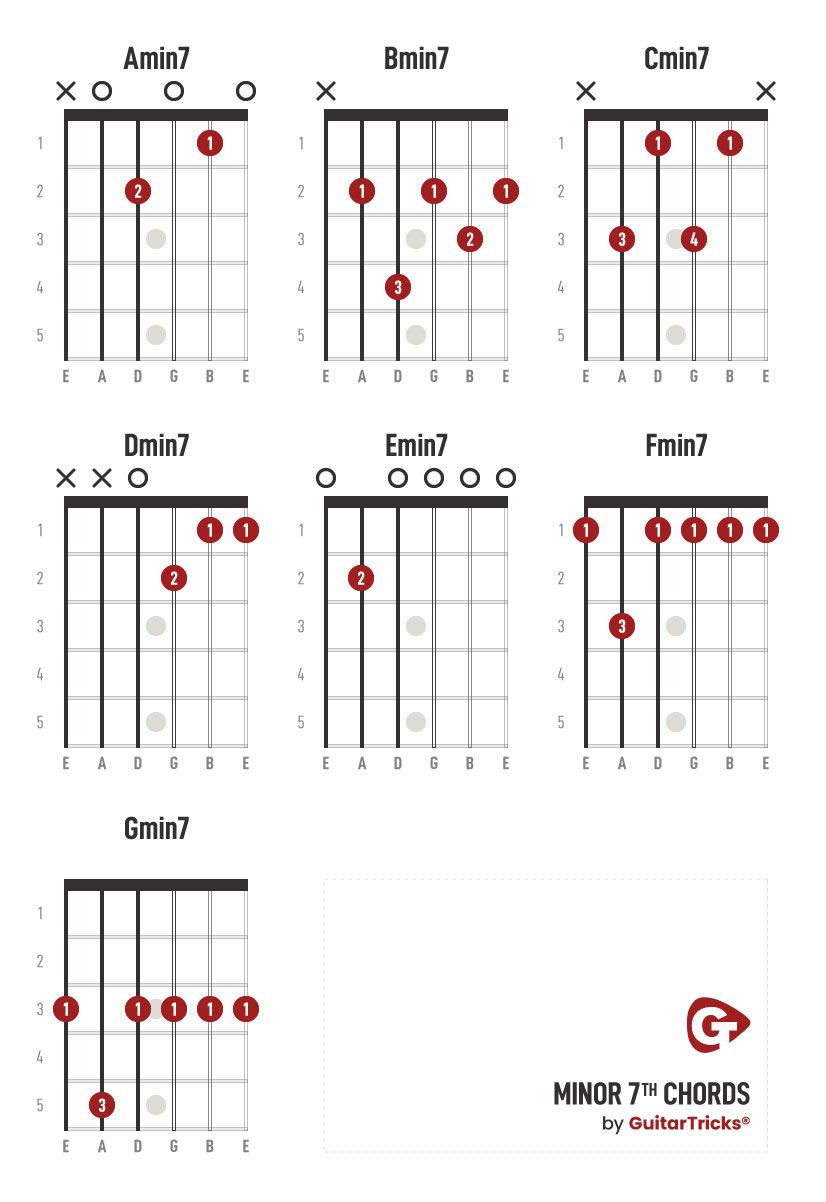
Augmented Guitar Chords Chart
Augmented chords are very dissonant but can be used in very creative ways. Where the diminished chord pulls to a major chord, the augmented chord is a bit static and doesn’t have much weight pulling in any particular direction, major or minor. Augmented chords, designated with ‘aug’ or a ‘+’ symbol, are built on two major 3rd intervals stacked on top of each other. Another way to think of this would be to raise the 5th of any chord up a half-step and you’ll get an augmented chord. Below is a diagram of augmented chord fingerings.
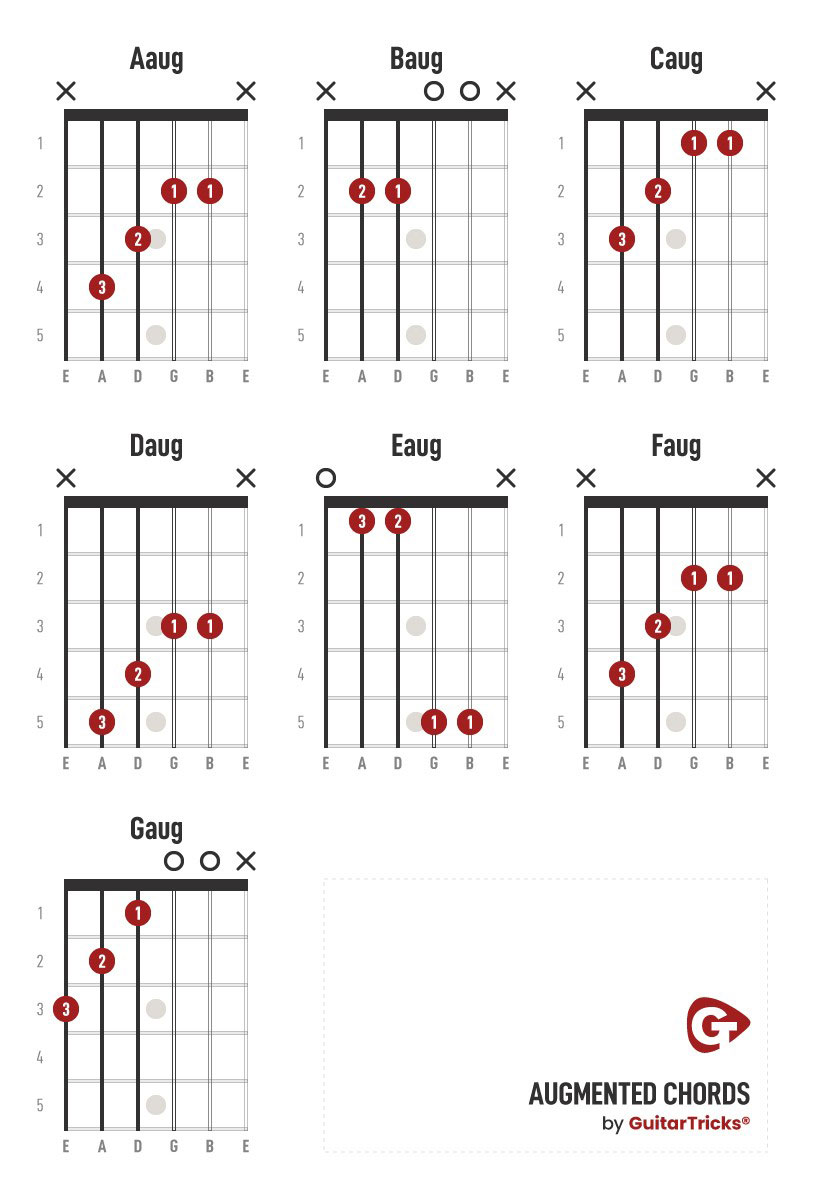
Diminished Guitar Chords Chart
Below you will find fingerings to the basic diminished chords, often written as ‘dim’ or with a small circle ‘o’. These chords have a lot of tension in them because of the interval of a tri-tone built into the chord structure. These chords need to ‘go somewhere’ in a progression and resolve well to a major chord. Below are fingering diagrams of some basic diminished chords.
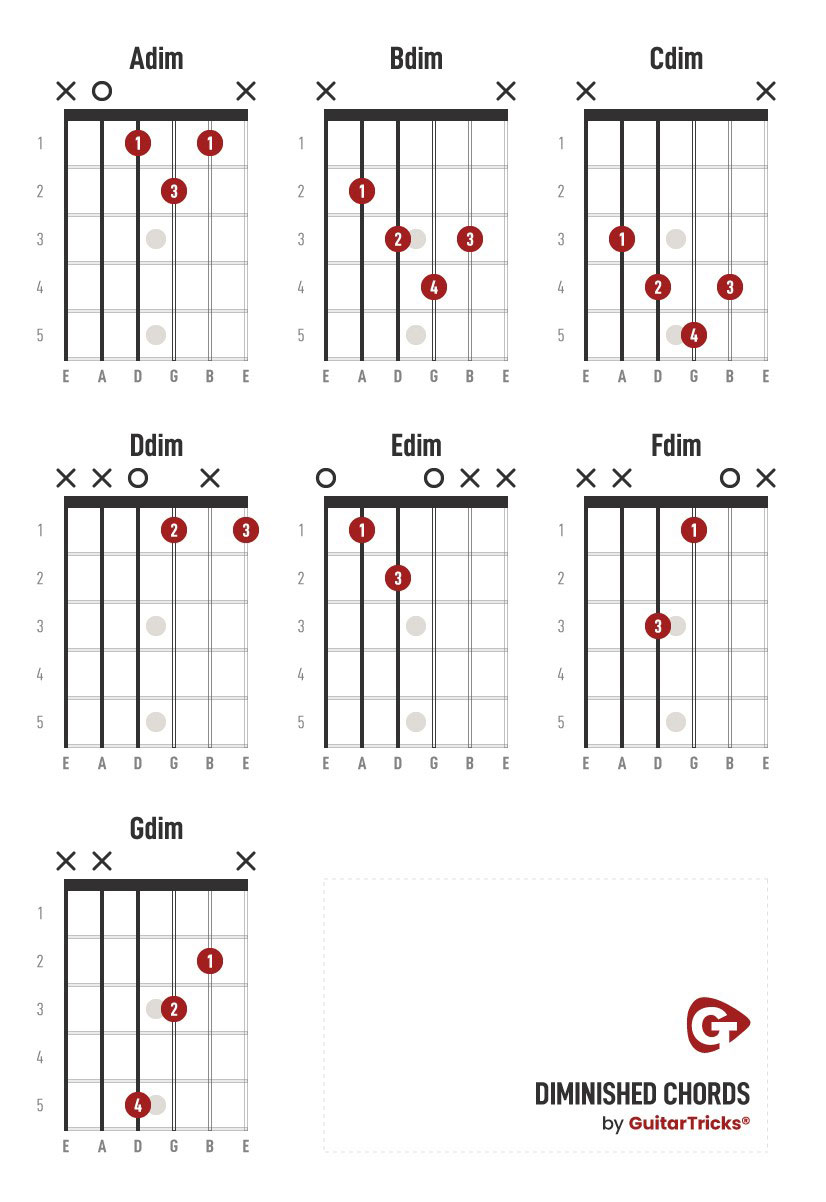
Frequently Asked Questions About Chords
What are the 4 main types of chords?
The four main types of guitar chords are major chords, minor chords, augmented chords, and diminished chords. They're like the basic building blocks for a ton of songs.
What are the 8 basic chords?
The eight basic chords you'll bump into a lot are C major, A major, G major, E major, D major, A minor, E minor, and D minor. Pretty much the starter pack for beginner guitarists.
What is the hardest chord to learn?
The F chord is notorious for giving beginners a hard time. Mainly because it's a barre chord on the very first fret, which is the most difficult fret to press down on the strings. Especially the low E string.
What are the 4 most popular chords?
The four most popular chords you'll come across are the C major, G major, A minor, and F major. Together, they're known as the "Four Chord Song" combo, famous for playing a ton of pop songs.
Which guitar chords should you learn first?
Definitely start with the E minor and C major; they're the gateway chords for many songs and are pretty friendly for beginners. They'll get your fingers moving without too much fuss.
What is the 1 3 5 rule for chords?
The 1 3 5 rule is a music theory cheat code that tells you to build a chord using the first, third, and fifth notes of a scale. This formula gives you the major chord for any key, which is pretty cool and useful.
How do you memorize guitar chords?
Practice, practice, and more practice, plus visualizing the chord shapes and where your fingers go on the fretboard helps a ton. Additionally, playing easy songs you love makes it way more fun to remember different chords.